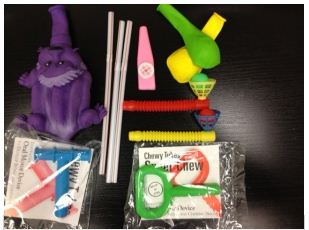OT Corner: Questions about Oral Motor Input and their Answers
Editor’s Note: The following article was written by an OTR for parents. We thought it was an excellent piece for you to share with the parents of your kiddos as well.

by: Stephanie Erickson OTR/L, OTD
Why is my child always putting things in his or her mouth?
When a child puts something in his mouth, he or she may be seeking oral motor input, which basically includes anything that gives the child sensory input to the mouth and may result in a motor behavior such as sucking or chewing. In short, oral motor input is organizing, meaning that it provides us with sensory input that elicits motor behaviors that help us calm down and focus. This is true not only for infants and children, but across the lifespan. In fact, before babies are born, they develop a sucking reflex that will allow them to feed and get nourishment. Thus, from the early stages of life, we learn that getting input through our mouths is a way to satisfy our more basic needs (i.e. nourishment) so that we can focus on more complex needs (e.g. learning from our environment, engaging in social interaction). Even older kids and grown-ups sometimes continue to seek oral motor input- think about chewing gum, biting nails, snacking “just because” or chewing on a straw or pen.
What’s the big deal?
Seeking oral motor input can become problematic once children move beyond the toddler stage, as it becomes socially inappropriate and of course potentially unsafe for them to be indiscriminately putting things in their mouths. Children may develop maladaptive patterns such as overeating, biting other children, or mouthing objects that are potential choking hazards.
What can I do about it?
We can use behavioral strategies to “teach” older children not to put toys or other inedible things in their mouths; however this may not change their basic need or craving for it. This is why we shouldn’t just ignore it- it certainly won’t do kids any good in the long run, particularly in the social arena, to allow them to mouth toys that are shared by other kids in the classroom, chew on their sleeves, bite their siblings during horseplay, or chew the ends of their pencils to bits. What we can do in these cases is provide alternatives or preparatory strategies to meet the child’s oral motor needs (see list below). This means either anticipating the need and providing oral motor options ahead of time, or having alternatives on hand to replace the inappropriate object/behavior.
What are safe/appropriate ways to provide my child with oral motor input?
- Use an electronic/vibrating toothbrush in the morning before school
- Chew foods that are crunchy like carrots or pretzels, chewy like taffy or peanut butter, sour like citrus fruits, or icy cold like a popsicle
- Drink something sour like water flavored with lemon juice (for more input, use a narrower straw)
- Use a thick straw to eat yogurt, pudding, or jello
- Play with whistles, harmonicas, blow bubbles, or blow up balloons
- Use a “chewy” or a vibrating teether
Remember, children should be supervised during oral motor activities to make sure they are using these tools safely!
Featured Guest Columnist: Stephanie Erickson, OTR/L, OTD
About Stephanie: Stephanie received a dual Bachelor’s degree in Psychology, Human Services concentration and Spanish Language from DePaul University in Chicago, IL. She completed her Master’s in Occupational Therapy at the University of Illinois at Chicago, followed by her Doctorate of Occupational Therapy.
Prior to graduate school, Stephanie worked with adolescent parents and their babies and became more interested in OT through volunteering at a multidisciplinary pediatric developmental center. During graduate school she enjoyed volunteering in the neonatal intensive care unit (NICU). She has completed post-Master’s work in a community-based educational organization in Peru and in the NICU. Stephanie has served as a guest lecturer in OT master’s courses and continuing education lectures. She has presented OT-related research findings at local, state, and national conferences, as well as co-authored articles published in occupational therapy and pediatric journals. Prior to moving to the Bay Area Stephanie worked with families in early intervention and held a position as adjunct clinical instructor in OT. Stephanie has experience working with infants and children with a variety of diagnoses, including developmental delay, prematurity and associated complications, sensory processing differences, autism spectrum disorders, Down syndrome, fetal alcohol syndrome disorders, and others. She particularly enjoys problem solving to help children, along with their families and caregivers, feel more successful in their everyday lives.
Please support our contributing authors and visit Starfish Therapies
PediaStaff is Hiring!
All JobsPediaStaff hires pediatric and school-based professionals nationwide for contract assignments of 2 to 12 months. We also help clinics, hospitals, schools, and home health agencies to find and hire these professionals directly. We work with Speech-Language Pathologists, Occupational and Physical Therapists, School Psychologists, and others in pediatric therapy and education.
